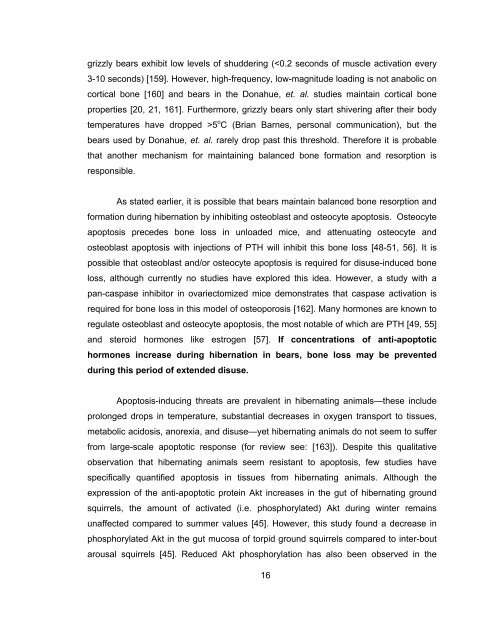C - Michigan Technological University
C - Michigan Technological University
C - Michigan Technological University
- No tags were found...
Create successful ePaper yourself
Turn your PDF publications into a flip-book with our unique Google optimized e-Paper software.
grizzly bears exhibit low levels of shuddering (5 o C (Brian Barnes, personal communication), but thebears used by Donahue, et. al. rarely drop past this threshold. Therefore it is probablethat another mechanism for maintaining balanced bone formation and resorption isresponsible.As stated earlier, it is possible that bears maintain balanced bone resorption andformation during hibernation by inhibiting osteoblast and osteocyte apoptosis. Osteocyteapoptosis precedes bone loss in unloaded mice, and attenuating osteocyte andosteoblast apoptosis with injections of PTH will inhibit this bone loss [48-51, 56]. It ispossible that osteoblast and/or osteocyte apoptosis is required for disuse-induced boneloss, although currently no studies have explored this idea. However, a study with apan-caspase inhibitor in ovariectomized mice demonstrates that caspase activation isrequired for bone loss in this model of osteoporosis [162]. Many hormones are known toregulate osteoblast and osteocyte apoptosis, the most notable of which are PTH [49, 55]and steroid hormones like estrogen [57]. If concentrations of anti-apoptotichormones increase during hibernation in bears, bone loss may be preventedduring this period of extended disuse.Apoptosis-inducing threats are prevalent in hibernating animals—these includeprolonged drops in temperature, substantial decreases in oxygen transport to tissues,metabolic acidosis, anorexia, and disuse—yet hibernating animals do not seem to sufferfrom large-scale apoptotic response (for review see: [163]). Despite this qualitativeobservation that hibernating animals seem resistant to apoptosis, few studies havespecifically quantified apoptosis in tissues from hibernating animals. Although theexpression of the anti-apoptotic protein Akt increases in the gut of hibernating groundsquirrels, the amount of activated (i.e. phosphorylated) Akt during winter remainsunaffected compared to summer values [45]. However, this study found a decrease inphosphorylated Akt in the gut mucosa of torpid ground squirrels compared to inter-boutarousal squirrels [45]. Reduced Akt phosphorylation has also been observed in the16
















